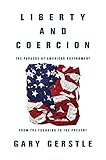Liberty and Coercion : The Paradox of American Government from the Founding to the Present / Gary Gerstle.
Material type: TextPublisher: Princeton, NJ : Princeton University Press, [2017]Copyright date: ©2018Description: 1 online resource (472 p.) : 1 tableContent type:
TextPublisher: Princeton, NJ : Princeton University Press, [2017]Copyright date: ©2018Description: 1 online resource (472 p.) : 1 tableContent type: - 9780691162942
- 9781400888436
- Abuse of administrative power -- United States -- History
- Federal government -- United States -- History
- Federal-state controversies -- United States -- History
- Political culture -- United States -- History
- HISTORY / United States / General
- Affirmative action
- African Americans
- Agriculture
- Amendment
- Americans
- Appointee
- Authority
- Ballot
- Big government
- Bill of rights
- Cambridge University Press
- Capitalism
- Central government
- Citizenship of the United States
- Citizenship
- Civil Rights Act of 1964
- Civil society
- Classical liberalism
- Coercion
- Commerce Clause
- Communism
- Constitutional amendment
- Constitutionalism
- Deliberation
- Democracy
- Dwight D. Eisenhower
- Economics
- Election
- Employment
- Federal government of the United States
- Foreign policy
- Fourteenth Amendment to the United States Constitution
- Freedom of speech
- Governance
- Governing (magazine)
- Government
- Homestead Acts
- Ideology
- Industrial relations
- Injunction
- Institution
- Jurisdiction
- Labour movement
- Legislation
- Legislator
- Legislature
- Liberalism
- Lochner v. New York
- Military–industrial complex
- National Labor Relations Act
- National security
- Naturalization
- New Federalism
- Police power (United States constitutional law)
- Police
- Political machine
- Political party
- Political science
- Politician
- Politics of the United States
- Politics
- Popular sovereignty
- Populism
- Princeton University Press
- Private sector
- Privatization
- Progressive Era
- Prostitution
- Provision (contracting)
- Public policy
- Racism
- Radicalism (historical)
- Ratification
- Regime
- Regulation
- Republicanism
- Right to privacy
- Sedition
- Slavery
- Sovereignty
- State government
- State law (United States)
- Statute
- Subsidy
- Substantive due process
- Surrogacy
- Tariff
- Tax
- Total war
- United States Bill of Rights
- United States Constitution
- Vanderbilt University
- Voting
- War effort
- Warfare
- Wealth
- Welfare state
- Welfare
- World War I
- World War II
- 320.473/049 23
- JK311
- online - DeGruyter
| Item type | Current library | Call number | URL | Status | Notes | Barcode | |
|---|---|---|---|---|---|---|---|
 eBook
eBook
|
Biblioteca "Angelicum" Pont. Univ. S.Tommaso d'Aquino Nuvola online | online - DeGruyter (Browse shelf(Opens below)) | Online access | Not for loan (Accesso limitato) | Accesso per gli utenti autorizzati / Access for authorized users | (dgr)9781400888436 |
Frontmatter -- Contents -- Acknowledgments -- Introduction -- PART I: Foundations, 1780s–1860s -- A Liberal Central State Emerges -- The States and Their Police Power -- PART II: Improvisations, 1860s–1920s -- Strategies of Liberal Rule -- Lessons of Total War -- Parties , Money , Corruption -- PART III: Compromises, 1920s–1940s -- Agrarian Protest and the New Liberal State -- Reconfiguring Labor - Capital Relations -- PART IV: American Leviathan, 1940s–2010s -- An Era of Near - Permanent War -- Breaking the Power of the States -- Conservative Revolt -- Conclusion -- Notes -- Index
restricted access online access with authorization star
http://purl.org/coar/access_right/c_16ec
American governance is burdened by a paradox. On the one hand, Americans don't want "big government" meddling in their lives; on the other hand, they have repeatedly enlisted governmental help to impose their views regarding marriage, abortion, religion, and schooling on their neighbors. These contradictory stances on the role of public power have paralyzed policymaking and generated rancorous disputes about government’s legitimate scope. How did we reach this political impasse? Historian Gary Gerstle, looking at two hundred years of U.S. history, argues that the roots of the current crisis lie in two contrasting theories of power that the Framers inscribed in the Constitution.One theory shaped the federal government, setting limits on its power in order to protect personal liberty. Another theory molded the states, authorizing them to go to extraordinary lengths, even to the point of violating individual rights, to advance the "good and welfare of the commonwealth." The Framers believed these theories could coexist comfortably, but conflict between the two has largely defined American history. Gerstle shows how national political leaders improvised brilliantly to stretch the power of the federal government beyond where it was meant to go—but at the cost of giving private interests and state governments too much sway over public policy. The states could be innovative, too. More impressive was their staying power. Only in the 1960s did the federal government, impelled by the Cold War and civil rights movement, definitively assert its primacy. But as the power of the central state expanded, its constitutional authority did not keep pace. Conservatives rebelled, making the battle over government’s proper dominion the defining issue of our time.From the Revolution to the Tea Party, and the Bill of Rights to the national security state, Liberty and Coercion is a revelatory account of the making and unmaking of government in America.
Mode of access: Internet via World Wide Web.
In English.
Description based on online resource; title from PDF title page (publisher's Web site, viewed 01. Dez 2022)


